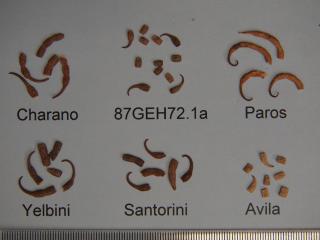Use in farming systems
SerraMax can be grown on acidic, sandy soils in 300 to 600mm annual rainfall areas. It is a nitrogen-fixing legume and needs to be sown with with the Group S strain of rhizobia. It has the potential to increase livestock carrying capacity and the residual value of a pasture phase to subsequent crop sequences.
When the seed pods of SerraMax are buried (shallow), there is a greater rate of hard-seed (dormancy) breakdown and more rapid germination compared to other cultivars of yellow serradella such as Yelbini, Charano and Santorini. This enables higher pasture regeneration densities and a greater ability to compete with early germinating weeds. Its particular seed germination traits will complement rather than replace the currently available cultivars of yellow serradella in rotational pastures. It will also expand the use of yellow serradella as the more rapid breakdown of hard-seed dormancy is better suited to longer pasture phases, particularly as a companion legume with sub-tropical perennial grasses.
Seed pods of SerraMax can be harvested with conventional harvesters in most seasons with >275mm growing season rainfall with about 40% harvest efficiency. This combination has resulted in 500 to 1000 kg/ha of harvested pod yield. Harvesting with vacuum harvesters is also an option, with a greater harvesting efficiency, but there is a greater risk of post-harvest soil erosion.
Seed can be extracted from pods (dehulling) but this process can be harder for SerraMax than for other cultivars of yellow serradella. The remaining un-dehulled seed has an enhanced germination and is a useable by-product. SerraMax has a high tendency for pod segmentation that, although reducing harvest and dehulling efficiency, improves the handling of bulk quantities of pod.


The greatest application of SerraMax is expected to be through the sowing of un-processed pod using the twin and summer sowing techniques. Twin sowing refers to the drilling of untreated serradella pod with a cereal or oilseed crop in autumn/winter.
The serradella will have little or no germination under the crop due to a high level of initial seed dormancy. This principle can also be applied when sowing sub-tropical perennial grasses in spring. The dormancy of the seed (in the pod) remains intact until exposed to high temperature (summer) and specific diurnal temperature fluctuations that occur in the soil surface over the following summer and early autumn. Summer sowing uses a similar concept except that the pod is not sown until late summer/early autumn, either into crop stubbles or established perennial grasses.
There is insufficient breakdown (around 50%) in the seed dormancy of the current yellow serradella cultivars to suit the twin and summer sowing techniques - unless impractical amounts of pod are sown. By comparison, almost all the hard-seed of SerraMax will break down by June (>90% hard-seed at sowing to 15% in mid-winter) when the seed is drilled into the soil at 0.5 to 1cm.
Disease reaction
The only serious diseases currently recognised in yellow serradella are collar and root rots at establishment due to rhizoctonia and pleiocheita. Screening for relative susceptibility to these diseases is not currently undertaken in the development of new pasture cultivars. Based on observation in field trials, SerraMax is no more susceptible than Santorini or Charano and is more tolerant than annual clovers.
Insect reaction
SerraMax is susceptible to native budworm during seed development, however the risk is lower compared to other cultivars of yellow serradella due to its early maturity. Regular monitoring for budworm is recommended in seed crops from the beginning of pod fill to senescence and the presence of any caterpillars should be controlled with an appropriate insecticide.
It is moderately susceptible to lucerne flea and appropriate control is recommended with serious infestations.
SerraMax is considered tolerant to blue green and cowpea aphids based on field observations and control should not be required in most situations.
It is considered moderately tolerant to red-legged earth mite based on glasshouse seedling screening and field observation. However early control is recommended in seed production crops.
Herbicide tolerance
Based of field observation and limited experimental data, SerraMax has a similar reaction to common herbicides as used on other cultivars of yellow serradella. It is tolerant of most grass selective herbicides but is highly susceptible to sulfonyl urea, phenoxy (MCPA, 2,4-D), glyphosate, triazine and paraquat/diquat based herbicides.
Seed availability
Commercial seed supplies are expected to be generally available in 2023. Some seed crops may be displayed at field days in 2022.



